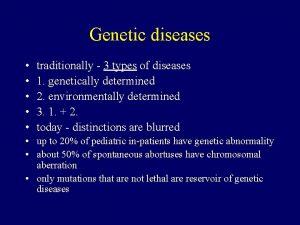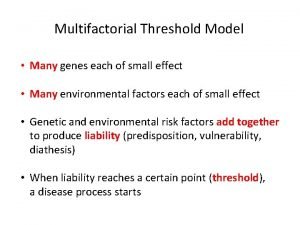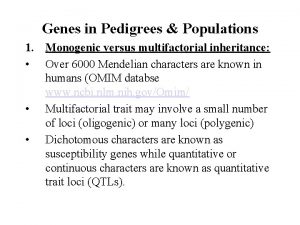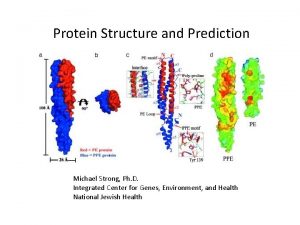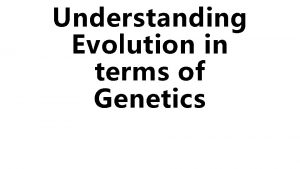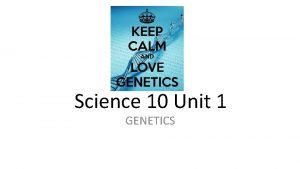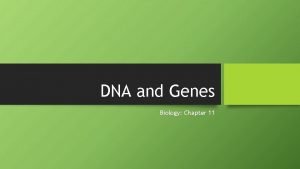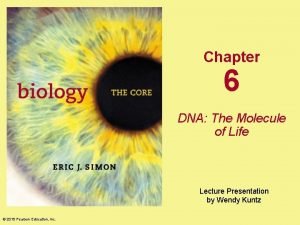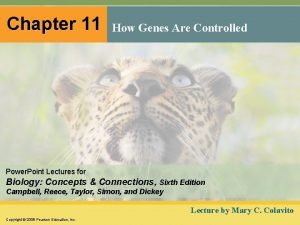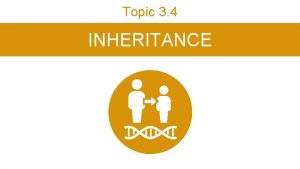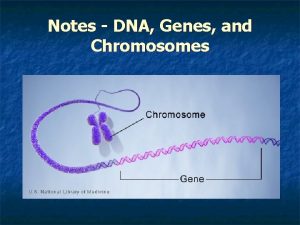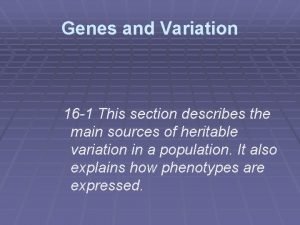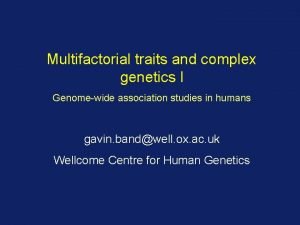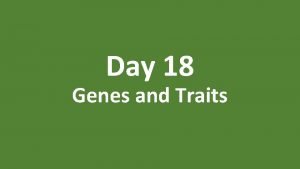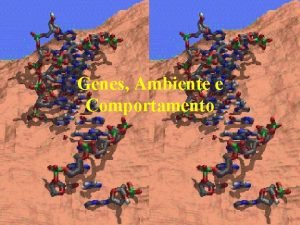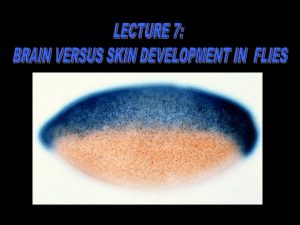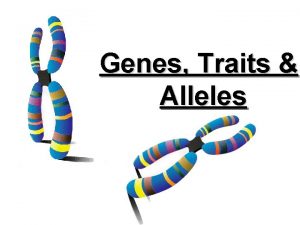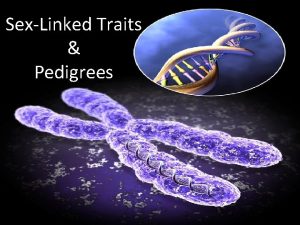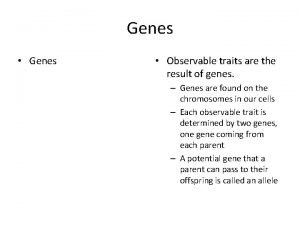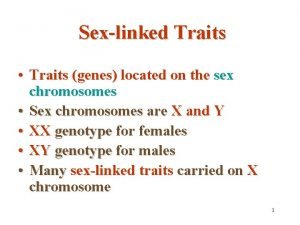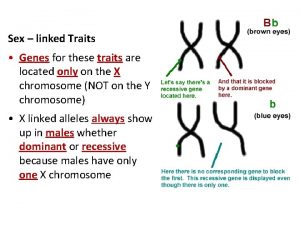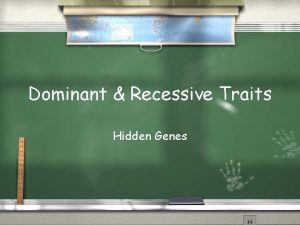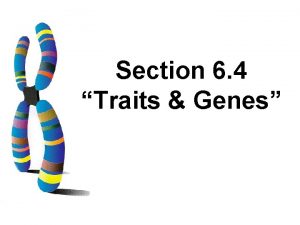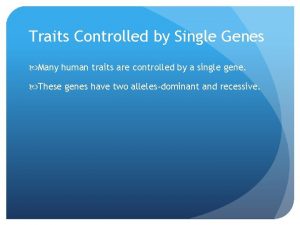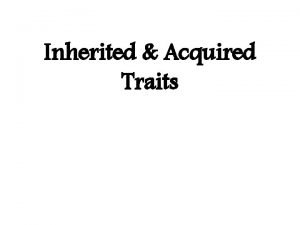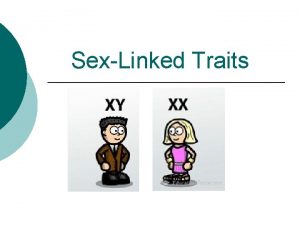Chapter 7 Multifactorial Traits Genes Environment and Traits












![Heritability [H] • Estimates the proportion of the phenotypic variation in a population due Heritability [H] • Estimates the proportion of the phenotypic variation in a population due](https://slidetodoc.com/presentation_image_h2/2db5664e1b03045c0dcff235add94400/image-13.jpg)
![Heritability [H] (2) Heritability [H] (2)](https://slidetodoc.com/presentation_image_h2/2db5664e1b03045c0dcff235add94400/image-14.jpg)












- Slides: 26

Chapter 7 Multifactorial Traits

Genes, Environment, and Traits • Few genes act alone • Environmental factors and other genes may modify expression • Traits can be described as – Mendelian — Caused by a single gene – Polygenic — Caused by multiple genes • Both can be multifactorial or complex due to an interaction between genes and the environment

Genes, Environment, and Traits (2) • Single-gene traits are discrete or qualitative – Often produce an all-or-none effect • Polygenic traits produce a continuously varying phenotype – AKA quantitative traits – DNA sequences involved are termed Quantitative Trait Loci (QTLs)

Genes, Environment, and Traits (3)

Polygenic Traits • Influenced by interaction of genes and by the environment • Examples – Height – Skin color – Body weight – Fingerprint patterns – Behavioral traits

Polygenic Traits (2) • Individual genes follow Mendel’s laws, but their expression is hard to predict • Effect of genes is additive or synergistic – Input of genes is not necessarily identical • Frequency of distribution of phenotypes forms a bell-shaped curve

Height

Height (2) • Difference in height between the students of the yester years and today are attributed to improved diet and better overall health • Genome-wide association studies have identified dozens of genes that affect height – Certain SNPs patterns are seen in individuals with periods of rapid height increase

Skin Color • Melanin protects against DNA damage from UV radiation, and exposure to the sun increases melanin synthesis • Humans have same number of melanocytes per unit area of skin – Differ in melanosome number, size and density distribution

Skin Color (2)

Investigating Multifactorial Traits • Empiric risk measures the likelihood that a trait will recur based on incidence • Incidence is the rate at which a certain event occurs • Prevalence is the proportion or number of individuals who have a particular trait at a specific time

Investigating Multifactorial Traits (2) • Cleft lip is more likely in a person who has a relative with the condition
![Heritability H Estimates the proportion of the phenotypic variation in a population due Heritability [H] • Estimates the proportion of the phenotypic variation in a population due](https://slidetodoc.com/presentation_image_h2/2db5664e1b03045c0dcff235add94400/image-13.jpg)
Heritability [H] • Estimates the proportion of the phenotypic variation in a population due to genetic differences
![Heritability H 2 Heritability [H] (2)](https://slidetodoc.com/presentation_image_h2/2db5664e1b03045c0dcff235add94400/image-14.jpg)
Heritability [H] (2)

Coefficients of Relatedness • Proportion of genes shared between two people related in a certain way

Adopted Individuals • Similarities between adopted people and adopted parents reflect mostly environmental influences • Similarities between adoptees and their biological parents reflect mostly genetic influences • Information on both sets of parents can reveal how heredity and the environment both contribute to a trait

Twins • Twin studies have largely replaced adoption methods • Concordance: Measures the frequency of expression of a trait in both members of monozygotic (MZ) or dizygotic (DZ) twins – Twins who differ in a trait are said to be discordant • For traits largely determined by genes, concordance is higher for MZ than DZ twins

Twins (2)

Separating Genetic and Environmental Influences • • Dizygotic twins - Shared environment and 50% of genes Monozygotic twins - Identical genotype and shared environment Twins raised apart - Shared genotype but not environment Adopted individuals - Shared environment but not genes

Single Nucleotide Polymorphisms (SNP) • Sites in a genome where the DNA base varies in at least 1% of the population • In these studies, SNPs span the genome, rather than define a single gene – SNP can be anywhere among our roughly 3. 2 billion base pairs

SNPs

Genome-Wide Association Studies • Older techniques search for known gene variants, typically in only a few people • Sequencing of the human genome and the Hap. Map project (which identifies SNPs) have led to a new tool • Seek correlations between SNP patterns and phenotypes in large groups of individuals

Tracking Genes in Groups • Genome-wide association studies seek SNPs that are shared with much greater frequency among individuals with the same trait than among others

Study Designs • Cohort study: Researchers follow a large group of individuals over time and measure many aspects of their health • Case-control study: Pairs of individuals are matched so that they share as many characteristics as possible – SNP differences are then associated with the presence or absence of the disorder

Study Designs (2) • Affected sibling pair strategy: Scans genomes of siblings for SNPs shared by those with the condition, but not by those who don’t have it • Homozygosity mapping: Performed on families that are consanguineous – Children in this case are more likely to inherit two copies of the mutation

Limitations of Genome-Wide Association Studies • Include so many data points and so are prone to error • Reveal associations between two types of information, not causes • Bias can be introduced in the way the patient population is selected • Accuracy is affected by complicating factors, such as phenocopy and epistasis • May miss extremely rare SNPs
 Linked genes and unlinked genes
Linked genes and unlinked genes Polygenic inheritance
Polygenic inheritance What are homeotic genes
What are homeotic genes Chapter 2 risk factors behavior genes environment
Chapter 2 risk factors behavior genes environment Expericorr design
Expericorr design Palin parent child interaction
Palin parent child interaction Multifactorial inheritance.
Multifactorial inheritance. Multifactorial threshold model
Multifactorial threshold model Limnked
Limnked Anova multifactorial
Anova multifactorial Asumciones
Asumciones Genes environment
Genes environment Genes to traits
Genes to traits Genes to traits
Genes to traits Chapter 11 dna and genes
Chapter 11 dna and genes Dna and genes chapter 11
Dna and genes chapter 11 Dna rna protein synthesis homework #2 dna replication
Dna rna protein synthesis homework #2 dna replication Financial environment in business environment
Financial environment in business environment The age of genes chapter 6
The age of genes chapter 6 Chapter 11 how genes are controlled
Chapter 11 how genes are controlled Hemizygous
Hemizygous Evolution of populations section 16-1 genes and variation
Evolution of populations section 16-1 genes and variation Dna, genes and chromosomes relationship
Dna, genes and chromosomes relationship How do you know if a karyotype is male or female
How do you know if a karyotype is male or female Genetics is the study of heredity
Genetics is the study of heredity Section 16-1 genes and variation
Section 16-1 genes and variation Evolution of populations section 16-1 genes and variation
Evolution of populations section 16-1 genes and variation






